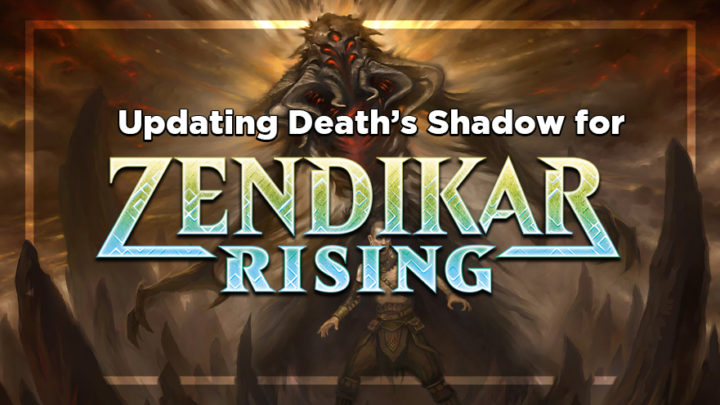Over the last couple of weeks, Rakdos Shadow has made a name for itself in Modern, putting up some solid results in challenges, and even picking up a win. While I believe Rakdos Shadow is a good deck, I think it also has some exploitable flaws, namely card quality and perhaps being too low to the ground. Before we can talk about what beats up on Rakdos Shadow, we need to figure out why it is built the way it is.
Rakdos Shadow By TuggaNaxos, 1st Place, MTGO Challenge
1 Mountain
1 Swamp
Sideboard
2 Kroxa, Titan of Death’s Hunger
Here we have TuggaNaxos’s challenge winning Rakdos Shadow list. Rakdos Shadow is the latest in a long line of hyper-aggressive decks centered around Monastery Swiftspear and Soul-Scar Mage.
Why add black to the hyper-aggressive red deck? When you are the aggressor you have the luxury of being fairly liberal with your life total because chances are your opponent is playing defensively and thus can’t pressure you back. Once you start taking advantage of a fetch/shock mana base, you begin to enter a world where Death’s Shadow is a real threat. Going slightly further into enabling Death’s Shadow allows you to make even better use of Thoughtseize and Phyrexian mana spells, as it turns the downside into profit! Mutagenic Growth with Death’s Shadow and either of the prowess creatures is a zero mana +5/+5, which can lead to some huge bursts of damage.
Once you’re in the business of being aggressive and lowering your own life to enable Death’s Shadow, you’ll find that both players are often at a fairly low on life. Earlier this year, it wasn’t profitable enough to go out of the way to add Death’s Shadow to the mix given the risk associated, but now that Scourge of the Skyclaves exists, that dynamic changes. In fact, the Rakdos Shadow decks are more Scourge of the Skyclaves decks with Death’s Shadow than the other way around. Having two powerful creatures that grow as you enact your game plan definitely makes the risk into reward.
The Exploitable Weaknesses
I do think because of the presence of Monastery Swiftspear and Soul-Scar Mage that Rakdos Shadow has the easiest time getting Scourge onto the battlefield. However, I’m not in search of the best Scourge of the Skyclaves deck, but the best deck using Scourge of the Skyclaves(and Death’s Shadow). Commonly decks that value speed will lack staying power, which means that decks with the ability to extend the game will win via higher card quality in the later turns. Soul-Scar Mage, Monastery Swiftspear, Lava Dart, and Mutagenic Growth all give Rakdos Shadow the speed it needs, but those cards are far less potent when you draw them on turn four.
Being too low to the ground means that decks have the ability to go over you but still under other decks. This means that there is space to prey on you, while being able to prey on your prey, which tends to lead to the bottom of that scale being absorbed by the deck that is one step bigger. Tarmogoyf has been one of the best turn two plays into prowess in Modern. Holding the ground during the early turns before pivoting into a threat is the best way to beat decks that try to go small. Fatal Push and Lightning Bolt are already powerful, and popular removal spells in Modern that both do a lot of work against Rakdos Shadow. Mix all three of those together, and you make your way into Jund, but the issue with classic Jund is that it doesn’t have closing speed. Taking control of the game without the ability to end it quickly means that your opponent has time to climb back in. That led me to Jund Shadow.
Jund Death’s Shadow By Michael Rapp
2 Kroxa, Titan of Death’s Hunger
Jund Shadow is all of the cards that I want from Jund to combat the small creature decks, but with the closing speed of Death’s Shadow and Scourge of the Skyclaves. Tarmogoyf, backed by 11 removal spells, should easily be enough to halt the aggression of the Rakdos deck, which lets you turn the corner fairly safely into the aggressor. The nice part is because of cards like Lava Dart and Mutagenic Growth, Rakdos Shadow doesn’t have the tools to stop you once you start attacking.
The main deck here is fairly straightforward, discard spells to bust up your opponent’s plan or clear a path to resolve your creatures. Employ Fatal Push, Lightning Bolt, Dismember, and Abrupt Decay to handle nearly any creatures on the other side of the board. Death’s Shadow, Tarmogoyf, and Scourge of the Skyclaves are your oversized, cost-efficient threats that are great on both offense and defense.
With the straightforward way that the main deck is built, the sideboard must be designed to cover your weaknesses. Veil of Summer, Wrenn and Six and Kroxa, Titan of Death’s Hunger are powerful options against interactive decks. Cleansing Wildfire and Assassin’s Trophy give you some real upgrades for the big mana matchups while pulling double duty against Oops All Spells and Belcher, as neither play basic lands. Nihil Spellbomb adds some low-cost graveyard hate that plays well with Lurrus. Liliana of the Veil and Anger of the Gods provides a bit more game against creature decks of various sizes.
What About Stubborn Denial?
If you know me, you know that I love Stubborn Denial; however, it’s just not what it once was. The two leading combo decks, Oops All Spells, and Devoted Druid, are both creature-based combos. Burn, which was another great spot for Stubborn Denial, has all but been replaced by prowess, and Lightning Bolt is much better in that matchup. That isn’t to say that Modern can’t return to a place where it is good, but the more Aether Vial in Modern, the worse Stubborn Denial is. Lightning Bolt operates in the other direction, which means that now is a good time to put down Stubborn Denial and start picking off small creatures.
Benefits and Costs of Scaling Up
Now moving the size slider up comes with both benefits and costs. Being slightly larger means that you’ll be better in “mirror” matches. By that, I mean you’ll be better against smaller decks with similar goals. Jund Shadow has a much easier time playing against the Aether Vial decks. Not only does Jund pack more removal, but it’s creatures have an easier time walling off the red zone.
I mentioned earlier that the Rakdos Shadow decks didn’t want to see Jund because it consists of a pile of cards that trade well with their cheap cards. As you move up the curve to Jund Shadow, your matchup against the midrange decks improves as your cards scale better later into the game, allowing you to keep pace. Adding green to the deck also gives you access to Veil of Summer, perhaps the single best card against interactive decks in Modern.
Trading speed for additional size can hurt in other matchups. Normally the combo matchups would get worse, but adding an extra three Inquisition of Kozilek certainly helps close that gap. Azorious based control decks get somewhat harder because your ability to truly get under them is slightly hindered, but the extra discard spells help here as well. Big mana decks get much harder in game one without either the speed of Rakdos or access to Stubborn Denial. Thankfully Cleansing Wildfire and Assassin’s Trophy can come out of the sideboard to help slow down Tron and Amulet Titan. Luckily big mana strategies seem notably low on play rate at the moment. Now is a great time to pick up Jund Shadow, while one of the deck’s predators isn’t popular.
Conclusion
Hopefully, if you’re looking to beat up on Rakdos Shadow, I’ve given you a solid place to start with Jund Shadow. If you have any other decks that you believe occupy a similar role or just any suggestions for Jund Shadow I’d love to hear them. You can always reach me on Twitter @RappaciousOne. I’ll catch you all back here next week with more Modern content as the format continues to evolve.

Michael Rapp is a Modern specialist who favors Thoughtseize decks. Magic sates his desire for competition and constant improvement.

